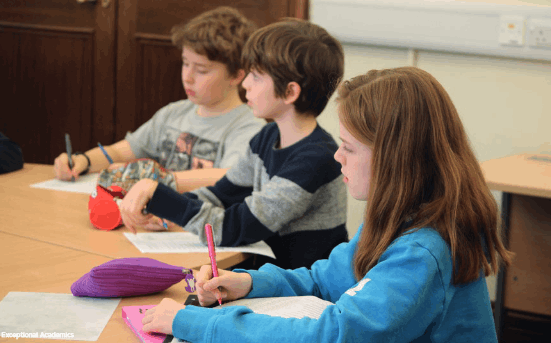Menu
It takes more than one approach to nurture a child with ADHD – nutrition, coaching, therapy, educational support, possibly medication, and lots of parental love all play a part. Wondering how to build a toolkit that covers it all? Georgina Blaskey spoke to the experts
ADHD is the most diagnosed and talked-about condition of educational special needs and one that can be eased with multiple approaches. One of the first areas to consider when understanding ADHD is nutrition. The nutrient that crops up most often as a deficiency in children with attention deficit is Omega-3. “Specifically, DHA is an essential Omega-3 fatty acid for the brain that helps with neurodevelopment and eye development, which needs to be gained through diet,” explains Lucinda Miller, nutritionist and founder of NatureDoc. “Over 90% of the Omega-3 in our brain is made of DHA which you can mainly get from eating oily fish and seafood. DHA feeds the frontal lobes which enable executive function such as planning, problem solving and sustained attention. Omega-3 is also a key nutrient for the prefrontal lobe of the brain, which is important for social, emotional and behavioural development.”

Minerals such as iron, zinc and magnesium are also important for the synthesis and release of the ADHD brain hormone dopamine and these nutrients are frequently low in children with ADHD. “Iron is abundant in foods like red meat and beans. Zinc is also available in meat, as well as shellfish, nuts and seeds. Good sources of magnesium include green vegetables, dark chocolate and nuts. Usually, there are shortfalls in other key vitamins such as vitamin D and a broad spectrum of B vitamins, all vital brain nutrients derived from a balanced diet and, in the case of vitamin D, from summer sunlight. These all support optimal brain cell nourishment.”
When genetic testing is performed on people with ADHD, inherited difficulties with making and synthesising dopamine and norepinephrine are usually identified. Nutrients such as magnesium and zinc are necessary building blocks for creating these brain hormones. Therefore, if a child is genetically predisposed to slow dopamine production or excessive norepinephrine production, they may require higher levels of these nutrients than other children to support their production and synthesis. This, in turn, can help manage lack of focus, impulsivity, procrastination, and other symptoms associated with ADHD.
“My approach to feeding children with ADHD is to focus on incorporating nutrient-dense foods into every meal. It is best to aim for a diet that is high in protein and healthy fats, with a lower carbohydrate content, as this helps to balance blood sugar levels, regulate energy and focus, and can prevent ‘hangry’ moments, meltdowns, and overwhelm,” advises Ms Miller, who also runs an online course on Nutrition and ADHD.
Vania Adams, educational consultant with Exceptional Academics, stresses how important it is to do your homework if you have a neurodiverse child: “Check if a school can meet your child’s needs, either through their facilities or their policies. Ask how those provisions are embedded in everyday school life. Can they accommodate regular movement and rest breaks, quiet time, or a fiddle toy?”

Self-esteem has a huge role to play for all students but more so with neurodiverse students. “The one single thing that makes the biggest difference is praise,” says Kirstie Richardson, Head of Learning Support at Whitgift. “If a student thinks they can do something, or moreover they know they will be praised for trying, they are much more likely to stay engaged – this needs lots of extra individual time though. Lessons must be very organised and have a clear pattern that can be followed. The content will change but the expectations need to be clear to all. Having both verbal and visual instructions helps when working memory is overloaded, which enables students to find their place when they have drifted off or been distracted.”
Finally, listen to them and spend time with them whenever they ask, try to find a shared interest that is not school-related that you can both enjoy so they know your love is unconditional. “Praise effort over results every time. They may take longer and feel more exhausted than neurotypical students – understand this and build in support for them, be their cheerleader whilst they learn to advocate for themselves,” adds Richardson.
Coaching focuses on the future with a key emphasis on goals, creating change and empowering clients with behaviours and strategies for everyday situations. It is ‘action-based’, which means it helps to address practical problems, helping the child to shift in the here and now. “An ADHD coach takes the role of mentor, teacher, role model and personal cheerleader,” explains Ben Isaacson from ADHD Confident. “Many ADHDers grow up with a huge lack of confidence and self-esteem, so providing this positive energy is crucial to their progress from week to week. ADHD-specific coaches have a specialist knowledge of the specific challenges of ADHD, which is something many practitioners, coaches and clinicians are not familiar with, particularly in areas such as RSD (Rejection Sensitive Dysphoria) and emotional dysregulation.”
Normally, coaching sessions are 45 minutes long, once a week. While some children will require several months of coaching to get through their studies, others are better suited to a long-term coaching relationship. “When it comes to ADHD coaching, there has to be a certain level of maturity,” advises Isaacson. “This is why I usually coach children from the age of 11, and the child has to want to be there. From my experience, the only way to change a child’s behaviour is for them to find the motivation to do so. I aim to help them find that path, which is what leads to sustainable lasting change. Each week, we spend time exploring your child’s challenges through an ADHD lens and find ways to make the changes they’re looking for. I use the coaching space to see what is and isn’t working, and explore strategies unique to the individual needs of the child.”

Behavioural therapy for both children and parents should aim to support the child in the family setting and school environment. Cognitive behavioural therapy (CBT) focused on ADHD specifically should be delivered by a trained psychotherapist or psychologist. “Dependent on the age of the child, therapy varies: from role play to play therapy, and utilising senses depending on what the child responds to, be it a more tactile approach or drawing,” says Sol Matossian, Integrative Child & Adolescent Psychotherapist at The Soke.
“Working collaboratively with the school, we would focus on the current challenges the child is navigating in order to devise suitable behavioural strategies. For children between 10 and 12-years-old, session time with a therapist is usually split 50/50. This means that there will be a session alone with the child to gain a sense of the child’s experiences, and separately a session with the parents to gauge their feedback. This arrangement may vary according to each individual family depending on the dynamics. Sometimes if there are siblings, it may be beneficial to allow them to join.”
A typical session would look at current behaviour that the parents may find annoying or want to change, for example, playing less video games. The therapist, child and parents may look for cues or clues to see what it is that the child is engaging with, reinforcing and harnessing the positives of the behaviour. It may be that the child is highly effective at problem solving and executive functions when playing video games, which can be useful if transferred to real life experiences. Ultimately, it is about empathising with the parents and the child and ensuring that boundaries are more flexible to ensure success for both.
THE TELL-TALE SIGNS OF ADHD
The symptoms of ADHD in children fall into two groups. Some children experience both groups of symptoms. The condition may present differently in girls and boys.
Inattentiveness:
• Short attention span
• Getting distracted easily
• Constantly switching tasks
• Difficulty with organisation
• Forgetting or losing things
• Not finishing more involved tasks
• Having trouble listening or following instructions
• Making careless mistakesSymptoms of hyperactivity and impulsiveness include:
• Interrupting people
• Trouble waiting their turn
• Constantly fidgeting
• Running or climbing aimlessly
• Talking excessively
• Trouble sitting still
• Acting without considering consequences
• Unaware of dangerSource: Kove mental healthcare clinic
Both therapy and medication can help children manage ADHD, and often a combination of the two works best. Dr. Jenna Vyas-Lee, clinical psychologist and co-founder of mental healthcare clinic Kove, explains the process. “For your child to receive an ADHD diagnosis, they need to be formally assessed by a child ADHD specialist. This could be a clinical psychologist, a psychiatrist, or a paediatrician. A GP can’t formally diagnose ADHD, but they can refer you to a specialist. There isn’t one simple test for ADHD. A health professional can only reach a diagnosis after a detailed assessment.
Assessment for medication is a collaborative approach and decision by all the key stakeholders – parents, doctors, teachers and the child. A psychiatrist prescribes the medication. Medications available to treat ADHD include Methylphenidate, Lisdexamfetamine, Dexamfetamine, Atomoxetine, and Guanfacine.”
Medication can be tweaked to fit the individual. “Many people only take it during term time, or in the week. It really depends on symptoms and any potential side effects. Some people take it everyday. As with all medications there are a range of side effects that the psychiatrist will discuss with you so you can make an informed decision. The main one is potentially issues with appetite and making sure the child stays a healthy weight as many of the medications have an appetite suppressant effect.”